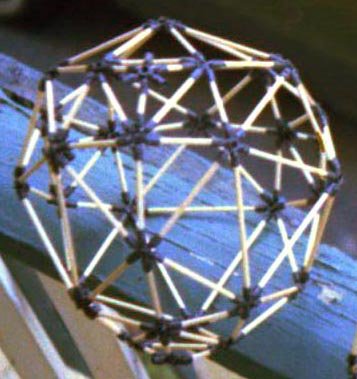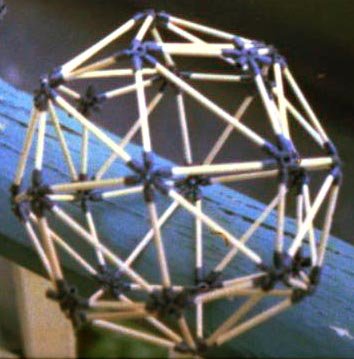
4ν Class I Tetrahedral Geodesic

4ν Class I Tetrahedral Geodesic
All the geodesic buildings I've seen are based on the icosahedron, but I found geodesics based on the tetrahedron made fascinating models. The most interesting part was finding all the great circles embedded in the figure. This 4ν (Class I or "alternate" breakdown) tetrahedral geodesic seemed to be especially good for that. Hugh Kenner's geodesic math provided all the formulas. As far as mathematics was concerned, it was far and away the best book I found.
There is a tetrahedral vertex toward the top and slightly left side of this photo. Three sticks emanating from it divide a triangle into thirds. I think the vertex sticks out slightly more than it should meaning I cut the dowels a bit too long.
In geodesic math, p. 52, Hugh Kenner reports that the Class II breakdown was actually formulated before the Class I breakdown, hence it's label as the "alternate" breakdown. Being an English major, Kenner hints that maybe they should have used the word "alternative". The Class II breakdowns can be thought of as Class I breakdowns applied to the triangulated faces of the cube, rhombic dodecahedron and rhombic triacontahedron rather than the tetrahedron, octahedron and icosahedron.
Below is the Class II version of the figure. I found it less interesting since fewer great circles could be traced out. It's like a spherical projection of a cube. The cube of course is the polyhedron it's based on. Each face of the cube corresponds to an edge of the tetrahedron. It's somewhat like a dual relationship, except in the dual there is a two-way correspondence between vertices and faces rather than this one-way correspondence between edges and faces.

4ν Class II Tetrahedral Geodesic
Fuller's view of symmetry based on equatorial great circles rather than polar axes was a revelation to me. The symmetries of a figure can be traced out as great circles on a sphere. One great circle corresponds to each axis of symmetry. Fuller came up with many esoteric relationships, the one which surprised me most being the unfolded quanta module he found embedded in the great circles of the icosahedron (see Section 902.33 on p. 487 of Synergetics).
I assembled these on September 13, 1981, four days after acquiring my own copy of the first volume of Synergetics. Previously I had been using Tufts' copy.


